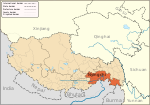Guxiang Lake
Guxiang Lake (Chinese: 古乡湖; Tibetan: གུ་ཤང་མཚོ), is a freshwater barrier lake located in Guxiang Village, Bomê County, Tibet Autonomous Region, China. [1]
Situated at an altitude of 2,600 meters, it spans 5 kilometers in length and 2 kilometers at its widest point, covering 20,000 square meters with a maximum depth of over 20 meters. Formed in 1953 due to a massive debris flow triggered by glacial activity from the nearby Xionglu Geini Glacier, the landslide blocked the Parlung Tsangpo River, creating this serene lake known for its mirror-like surface.[2]
Geography
Dense forests and low-altitude marine glaciers, a rare combination, surround the lake. Its central feature is Ago Milha Island, a 300-acre islet covered with pine and willow trees, while submerged tree trunks near the shores create ghostly underwater landscapes. Seasonal blooms of rhododendrons along the banks contrast with the glacial peaks, supporting diverse bird species and serving as a critical habitat within the southeastern Tibetan ecosystem.[3][4]
Culture
Culturally, the lake lies along the historic Sichuan-Tibet Highway (G318), blending natural spectacle with human activity. Local Tibetan communities historically utilized the area for grazing, though modern tourism now dominates, with lodges ranging from budget hostels to luxury lakeside resorts offering views of the Nyainqêntanglha mountain range.[5] Despite frequent debris flows (over 6,000 recorded since 1953), the lake remains a symbol of resilience, balancing ecological fragility with its role as a gateway to Tibet's glacial heritage.[3]
References
- ^ 中国大香格里拉经济圈研究 (in Chinese). 西南财经大学出版社. 2006. p. 55. ISBN 978-7-81088-531-7. Retrieved 2025-02-18.
- ^ "健康中国创意城市走进波密古乡湖". 波密县_网易订阅 (in Chinese). 2023-03-18. Retrieved 2025-02-18.
- ^ a b "川藏线上温婉的存在——古乡湖,万千美好不及它缓缓而来_西藏_波密_冰川". 搜狐 (in Chinese). 2022-04-17. Retrieved 2025-02-18.
- ^ 游遍西藏 (in Chinese). 四川美术出版社. 2006. p. 188. ISBN 978-7-5410-2998-1. Retrieved 2025-02-18.
- ^ 中国科学院. 地理科学與资源研究所; 中国地理学会 (2008). 中国国家地理 (in Chinese). 地理知识杂志社. p. 41. Retrieved 2025-02-18.

